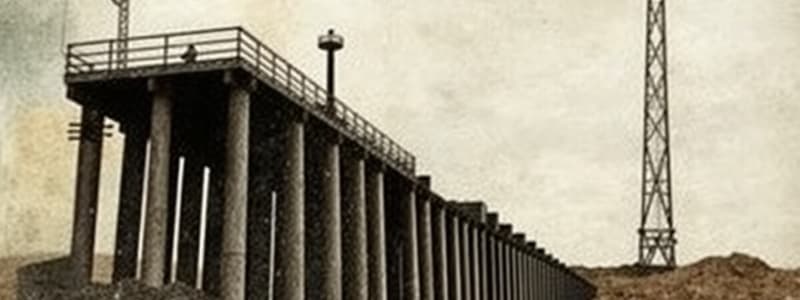Podcast
Questions and Answers
What can potentially damage concrete piles in organic soils?
What can potentially damage concrete piles in organic soils?
- Heavy machinery movement
- Acid formation from organic materials (correct)
- High moisture content
- Temperature fluctuations
What is a primary disadvantage of using concrete piles in marine environments?
What is a primary disadvantage of using concrete piles in marine environments?
- Vulnerability to freezing
- Difficulty in installation
- Abrasion from wave action (correct)
- Limited load-bearing capacity
Which of the following does NOT affect the selection of piles?
Which of the following does NOT affect the selection of piles?
- Length of the pile (correct)
- Availability of construction materials
- Soil type
- Environmental conditions
Which method is used to determine the ultimate bearing capacity of a pile?
Which method is used to determine the ultimate bearing capacity of a pile?
What is a characteristic of driven piles compared to bored piles?
What is a characteristic of driven piles compared to bored piles?
Which type of piling technique involves replacing the soil?
Which type of piling technique involves replacing the soil?
What does static analysis for load capacity of pile include?
What does static analysis for load capacity of pile include?
What type of pile is used primarily to resist tensile forces?
What type of pile is used primarily to resist tensile forces?
What is primarily considered when evaluating the efficiency of a pile group?
What is primarily considered when evaluating the efficiency of a pile group?
Which factor does NOT contribute to the efficiency of a pile group?
Which factor does NOT contribute to the efficiency of a pile group?
What is the bearing capacity factor (Nc) used in the calculation for the load capacity of the group?
What is the bearing capacity factor (Nc) used in the calculation for the load capacity of the group?
In the provided example, what is the total load capacity (Q) of the pile group calculated to be?
In the provided example, what is the total load capacity (Q) of the pile group calculated to be?
Which settlement influences the efficiency of the pile group after pile driving?
Which settlement influences the efficiency of the pile group after pile driving?
What is one of the primary reasons for the need for a pile foundation?
What is one of the primary reasons for the need for a pile foundation?
What is the maximum load capacity for timber piles under usual conditions?
What is the maximum load capacity for timber piles under usual conditions?
Which of the following statements regarding steel piles is false?
Which of the following statements regarding steel piles is false?
What is the optimum length for prestressed concrete piles?
What is the optimum length for prestressed concrete piles?
Which type of pile is formed by tensioning high strength steel prestress cables?
Which type of pile is formed by tensioning high strength steel prestress cables?
What is a major disadvantage of steel piles?
What is a major disadvantage of steel piles?
What type of construction allows for concrete piles to have high load capacities and resistance to bending?
What type of construction allows for concrete piles to have high load capacities and resistance to bending?
How are cast in place concrete piles formed?
How are cast in place concrete piles formed?
What indicates that the ultimate load has been reached during pile testing?
What indicates that the ultimate load has been reached during pile testing?
How is the load released after reaching the ultimate load in pile testing?
How is the load released after reaching the ultimate load in pile testing?
What is the required condition for holding the load constant in pile testing according to IS code?
What is the required condition for holding the load constant in pile testing according to IS code?
In a group of closely spaced piles, what is a key factor affecting bearing capacity?
In a group of closely spaced piles, what is a key factor affecting bearing capacity?
Which statement is true regarding the bearing capacity of friction pile groups?
Which statement is true regarding the bearing capacity of friction pile groups?
What happens to the load carrying capacity of combined friction and end bearing piles?
What happens to the load carrying capacity of combined friction and end bearing piles?
What approach is used to estimate the bearing capacity of a group of friction piles?
What approach is used to estimate the bearing capacity of a group of friction piles?
When increasing the load during pile testing, how long should the load be held when the working load is reached?
When increasing the load during pile testing, how long should the load be held when the working load is reached?
Flashcards are hidden until you start studying
Study Notes
Need for Pile Foundation
- Necessary for structures with very large design loads.
- Essential when soil conditions are poor at shallow depths.
- Utilized in sites with constraints, e.g., property lines.
Timber Piles
- Made from tree trunks, installed with the small end as a point.
- Maximum length is 35 m; optimum length ranges from 9 to 20 m.
- Typical maximum load: 450 kN; optimum load range: 80 - 240 kN.
- Advantages: High availability, easy to work with.
- Disadvantages: Susceptible to decay and low durability.
Steel Piles
- Practically unlimited maximum length, with an optimum range of 12 to 50 m.
- Load capacity depends on maximum allowable stress and cross-sectional area.
- Common shapes include rolled HP shapes and pipe piles.
- Closed-end piles can be filled with concrete post-installation.
- Advantages: High load capacity and efficient under hard driving conditions.
- Disadvantages: Vulnerable to corrosion; can be damaged by obstructions.
Concrete Piles
- Types include precast, prestressed, cast in place, and composite constructions.
- Precast piles designed to resist bending during transport and lateral loads.
- Prestressed piles use tensioned high-strength steel cables.
- Max lengths: 10 - 15 m for precast and 20 - 30 m for prestressed.
- Load capacity varies: 900 kN for precast, 8500 kN for prestressed; optimum: 350 - 3500 kN.
- Advantages: High load capacities and corrosion resistance.
- Disadvantages: High initial costs, handling difficulties, susceptible to soil-induced damage.
Composite Piles
- Combination of materials, taking advantage of both timber and concrete properties.
Installation Techniques
- Displacement Piling: Earth is displaced as piles are driven in.
- Replacement Piling: Soil is removed to make space for piles.
Classification by Load Transfer
- End Bearing Piles: Transfer loads directly to the soil.
- Friction Piles: Load is supported through friction along the pile's surface.
- Tension Piles: Designed to resist upward loads.
- Compaction Piles: Used for ground improvement.
- Anchor Piles, Fender Piles, and Dolphins: Specific functions related to stabilization and marine applications.
Factors Affecting Pile Selection
- Load carrying capacity assessed through methods like static analysis, dynamic analysis, and pile load testing.
- Established through correlation with field tests (SPT, CPT, etc.).
Pile Load Testing
- Determines settlement and ultimate bearing capacity.
- Initial or routine tests involve applying incremental loads.
- Failure load reached when settlement exceeds a specific percentage of pile diameter, followed by recovery measurements.
Efficiency of Pile Group
- Closely spaced piles may experience overlapping soil resistance.
- Total bearing capacity of a group may differ from the sum of individual piles.
- Efficiency of group depends on factors like characteristics, spacing, and number of piles, calculated using efficiency factor (ηg).
Pile Spacing Considerations
- Affects overlapping stress distribution and foundation costs.
- Influences settlements from various causes, such as soil consolidation and groundwater level changes.
Example Calculation
- A pile group of 9 piles in soft clay with specific parameters illustrates load capacity estimation based on bearing and adhesion factors, underscoring practical applications of theoretical concepts in pile foundation design.
Studying That Suits You
Use AI to generate personalized quizzes and flashcards to suit your learning preferences.





